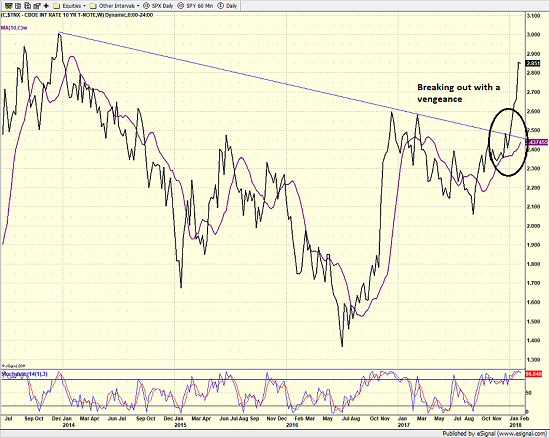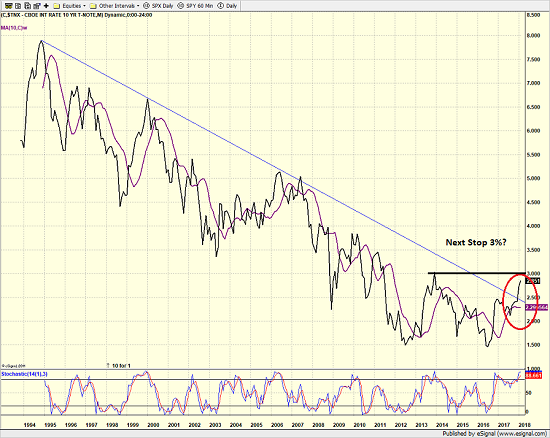Is This Really About Rates?
I usually don't write on Friday mornings. However, with the Dow experiencing its second quadruple-digit dance to the downside of the week yesterday, I figured it was probably time to make an exception.
The goal of this morning's hopefully not-so meandering market missive is to try and answer the key question of the day. As in, what the heck is going on here?
Okay, let's dive in and try to make some sense of yesterday's trash-job in the stock market. Cutting to the chase, the narrative seems to be that once you get past the high-speed algorithmic trading (those robos DO love following their trends on a millisecond basis!), the forced selling (can you say, "margin call?"), and the deleveraging that is likely occurring in hedgie-land (hey guys, maybe this isn't the time to have the pedal to the metal anymore, right?), the focus lands squarely on interest rates.
The Story of Rates - In Two Parts
In my opinion, there are really two parts to the rate story. First, there is the level of rates. And then there is the speed at which rates are rising.
The market can probably handle the first part. However, the second part means that something is changing and adjustments are being made - and being made quickly.
Lest we forget, bond yields have been rising for a while now. In other words, the rate move didn't start happening last week. The breakout that seems to be attracting everyone's attention began on December 19, 2017. And since that time, the yield on the U.S. 10-Year has risen from 2.39% to 2.85%. That's a pretty steep climb. And some will even argue that this move, like the stock market before it, has "gone parabolic."
One of the keys here is that along the way, the move in rates has broken some very long and very important trendlines, in pretty convincing fashion.
First, there is the downtrend on the weekly chart of 10-Year yields going back to the end of 2013. This four-year old trend was snapped when yields first broke through the 2.5% mark in the first week of January.
U.S. 10-Year Treasury Yield - Weekly 
View Larger Image Online
As you can see, this trendline has been broken with a vengeance.
Next is the downtrend line on the monthly chart going back to 1994.
U.S. 10-Year Treasury Yield - Monthly 
View Larger Image Online
While I can argue that a sustained break above 3% on the monthly chart would be more important from a technical perspective than a trendline break, I think it is safe to say that the breaking of a trend that is more than 23 years old might be significant.
Wait... Rates Rose When Stocks Tanked?
Getting back to yesterday's action, it is certainly odd that the yield on the 10-year rose while stocks were tanking. And this is part of the point - this doesn't usually happen. Sure, the yield pulled back from the highs as a modest flight-to-quality move occurred in response to the stock market's renewed upheaval. But the fact that bond yields rose yesterday morning is important.
The move appeared to be driven by the combination of (a) the new bi-partisan budget deal, which was struck in order to avoid another government shut-down and (b) some hawkish words from the Bank of England's Mark Carney.
Analysts point to the fact that the new budget deal increases spending by about $320 billion as a reason to fear higher rates. The bottom line is the U.S. Treasury is going to have to borrow even more money than had been anticipated. And given that the Fed is no longer buying anything and everything on the market, traders suggest that this, when added to the supply needed to cover tax reform, means rates are heading up - and fast.
The latter issue with the bond market - the one originating from across the pond - is also purported to be a problem. The Bank of England's Mark Carney said yesterday that his group may need to raise rates sooner than they had previously expected. This took the markets by surprise. And as everyone knows, markets don't like surprises.
Seismic Shift?
The bigger point here is that the global QE era is likely winding down. In short, this means that at some point, there won't be indiscriminate buyers of bonds without regard to price in the global bond markets anymore. And this represents what is being called a seismic shift in the landscape.
And what do you think this means for rates? Oh, that's right, they are expected to go higher - and sooner than folks were expecting.
Can You Say Multiple Contraction?
What does this have to do with the price of tea in China, err, the stock market, you ask? Aren't rates still low enough so as to not be serious competition to the market? And aren't rates also still low enough for economic and earnings growth to continue?
While I can argue that the answer to both questions posed is yes, it is important to remember that the multiple investors are willing to pay for a dollar of earnings changes as interest rates rise. And while this may sound a bit far-fetched, analyst Art Hogan reminds us that back when 10-Year yields were in the 5% zone, the average P/E for the S&P 500 was around 15.5, not the 18 seen today.
Do I "really" think that the S&P is experiencing "multiple contraction" this week? Uh, no. However, this type of thinking could certainly keep buyers on the sidelines longer than they might have been when rates weren't rising as fast as they are now.
In closing, let me say that rising rates is a fundamental issue that investors may be starting to grapple with. However, the bigger issue from a short-term perspective is the technical action, which hasn't been pretty at all. But then again, things can change quickly in this game and there are some pretty big inflation reports on the calendar for next week, which, of course, could certainly impact rates.
For now though, we need to get to next week's data. Here's hoping that some calm returns to the corner of Broad and Wall (oops, I mean the server farm in Mahwah, New Jersey) at some point soon.
Thought For The Day:
In the course of my life, I have often had to eat my words, and I must confess that I have always found it a wholesome diet. -Winston Churchill
Wishing you green screens and all the best for a great day,

David D. Moenning
Founder, Chief Investment Officer
Heritage Capital Research
Serving Financial Advisors since 1989
Serving individual investors since 1980
Questions, comments, or ideas? Contact Us
Disclosure: At the time of publication, Mr. Moenning held long positions in the following securities mentioned: None
Note that positions may change at any time.
Disclosures
The opinions and forecasts expressed herein are those of Mr. David Moenning and may not actually come to pass. Mr. Moenning's opinions and viewpoints regarding the future of the markets should not be construed as recommendations. The analysis and information in this report is for informational purposes only. No part of the material presented in this report is intended as an investment recommendation or investment advice. Neither the information nor any opinion expressed constitutes a solicitation to purchase or sell securities or any investment program.
Any investment decisions must in all cases be made by the reader or by his or her investment adviser. Do NOT ever purchase any security without doing sufficient research. There is no guarantee that the investment objectives outlined will actually come to pass. All opinions expressed herein are subject to change without notice. Neither the editor, employees, nor any of their affiliates shall have any liability for any loss sustained by anyone who has relied on the information provided.
Mr. Moenning may at times have positions in the securities referred to and may make purchases or sales of these securities while publications are in circulation. Positions may change at any time.
The analysis provided is based on both technical and fundamental research and is provided "as is" without warranty of any kind, either expressed or implied. Although the information contained is derived from sources which are believed to be reliable, they cannot be guaranteed.
Investments in equities carry an inherent element of risk including the potential for significant loss of principal. Past performance is not an indication of future results.
